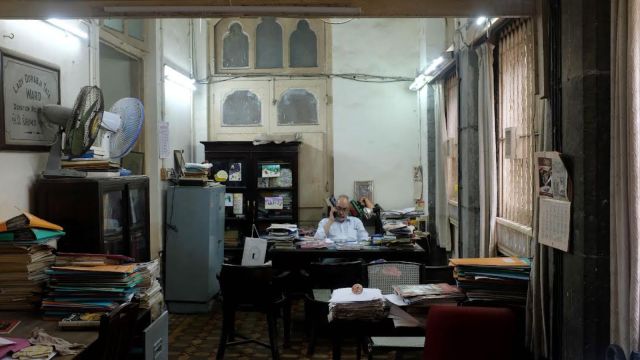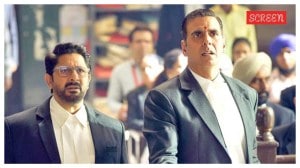‘End of an era’: After 60 years of covering Parsi events and raking up hot-button issues, Parsiana to publish its final edition in October
Helmed by Parsi founders and editors, and anchored by Parsi patrons, the fortnightly magazine was launched in 1964
 Jehangir Patel, the editor and publisher of Parsiana who bought the magazine in the 1970s, at its office in Mumbai’s Fort area. (Express Photo by Amit Chakravarty)
Jehangir Patel, the editor and publisher of Parsiana who bought the magazine in the 1970s, at its office in Mumbai’s Fort area. (Express Photo by Amit Chakravarty)In 1973, an article in Parsiana on the secluded Tower of Silence — a raised, circular tower where, as per the centuries-old Zoroastrian tradition, dead bodies are exposed to vultures — created an uproar in the orthodox Parsi circles of Mumbai.
Shiavax Vakil, then trustee of the Bombay Parsi Punchayet who had gained access to the tower, had penned a piece for the magazine about bodies lying exposed owing to the dwindling vulture population.
“While the issue was known since the 1900s, it had not been documented. In 1973, perhaps for the first time, someone had gone inside and written about the bodies lying around. It created an uproar, with people wondering how a layperson could enter the tower or talk about the customs of disposing,” says Jehangir Patel, the editor and publisher of Parsiana, now in his 80s.
This was not an isolated article.
Helmed by Parsi founders and editors, and anchored by Parsi patrons, Parsiana, a fortnightly magazine, has chronicled religious events, accomplishments and lives of the Zoroastrian community since its launch in 1964. Over six decades later, its closure announcement has sent yet another shock wave through the community.
 Jehangir Patel, the editor and publisher of Parsiana, pets Tiger, an Indie stray who grew up in the magazine’s corridors. (Express Photo by Amit Chakravarty)
Jehangir Patel, the editor and publisher of Parsiana, pets Tiger, an Indie stray who grew up in the magazine’s corridors. (Express Photo by Amit Chakravarty)
Besides the coverage of Parsi events, the magazine also voiced issues plaguing the community, often spoken in whispers. Despite its coverage leading to flared tempers within the more orthodox sections, Parsiana’s readership spanned from Mumbai to Pakistan and the United States. In its heyday, its subscriptions soared to 3,500. Its annual subscription in India costs Rs 1,200.
When The Indian Express visited the magazine’s office in Fort, the staff was busy with the upcoming October edition — typing stories, editing copies and attending to trilling landlines. Yet, a sense of gloom was all pervasive.
On a break, senior editor Sherene Vakil petted a restless Tiger, an Indie who grew up in Parsiana’s corridors. “I think he has sensed that our days here are numbered. He has become very needy,” she says.
The magazine’s journey
Parsiana was launched to chronicle the community’s life in November 1964 by Pestonji Warden, a Parsi doctor who also dabbled in the sandalwood trade. Faced with a dwindling readership, he sold it for a symbolic Re 1 to Jehangir Patel, who had returned from the US in 1970 after a two-year stint at The San Francisco Examiner and The Hartford Times.
 Parsiana’s latest edition, dated September 7-20, 2025. (Express Photo by Nayonika Bose)
Parsiana’s latest edition, dated September 7-20, 2025. (Express Photo by Nayonika Bose)
The magazine’s editor and publisher since August 1973, Patel, for as long as he can recall, has arrived at the office, tucked inside the now-defunct 138-year-old Parsi maternity hospital building, at 9.30 am. After overseeing administrative work, attending the 11.30 am editorial meetings on Wednesdays and editing copies, he wrapped up work by 4 pm.
Patel said Parsiana’s first edition in 1973 was brought out by a team of five, including two editors. “We sold 400 copies of that edition. Back then, journalistic coverage of Parsi events was not the norm,” he says.
The magazine also did not shy away from hot-button issues ailing the community: from the high divorce rates to inter-faith marriages. Not only did its stance affect its readership, its journalists also invited scorn from the community and high priests alike.
“Around 1987, we started covering inter-faith marriages of Parsis. People accused us of promoting inter-faith marriages. There was resistance, some even cancelled their subscriptions, but most eventually came around,” recalls Patel.
Recalling how her 40-year stint at Parsiana often landed her in trouble with the community, managing editor Parinaz Gandhi says, “Once, I wrote about permitting a person who had married outside of the faith entry into the Agiary (the Parsi fire temple). The priest of that Agiary was so upset that he never looked at me after that.”
Yet, Parsiana continued to publish issues surrounding the community. For instance, in its more recent edition, dated August 7-20, 2025, the magazine published articles on the urgent need to save the distinct “Parsi-Gujarati dialect”, which has its own syntax.
 Parsiana’s senior editor Sherene Vakil (right) writes for the magazine’s events and personality section. (Express Photo by Amit Chakravarty)
Parsiana’s senior editor Sherene Vakil (right) writes for the magazine’s events and personality section. (Express Photo by Amit Chakravarty)
“One of the main issues that we write about today is the dwindling Parsi population and the reforms needed. Mumbai only has 51 fire temples at present. The number of priests is down. Even devotees do not come to the fire temples as much,” says Patel.
End of an era
Come October 21, 2025, Parsiana will publish its final edition.
Editor Patel said that contrary to popular belief, it was not money that had led to the magazine’s closure. “We generally lose money on all editions, except for those in March and August, when Parsis celebrate Navroz. Yet, finance is not an issue. Our staff (of 16) is ageing and we have no one to take the baton forward (as a successor) due to the community’s declining population,” says Patel, adding that it takes around Rs10-15 lakh to push out one edition.
He said they print over 1,500 copies of Parsiana, though most readers prefer the e-magazine, launched on their website in 2005. While 60% of these hard copies are for Mumbai readers and 30% are for Parsis across India, the rest are sent to overseas subscribers, largely based in Canada.
Patel said the magazine is brought out by a “diligent team” of 16 — four editorial staffers, while the rest look after advertising, accounts, marketing and other operations.
 Editor Patel said that contrary to popular belief, it was not money that had led to the magazine’s closure. (Express Photo by Amit Chakravarty)
Editor Patel said that contrary to popular belief, it was not money that had led to the magazine’s closure. (Express Photo by Amit Chakravarty)
The editorial team got the first whiff of Parsiana’s closure in March.
“We lost a senior colleague to cancer in March. It was very difficult to fill that position since this is a niche publication with special requirements, knowledge of the community and contacts,” says senior editor Vakil, who writes for the magazine’s events and personality section.
With the magazine shutting down following its October 21 edition, its long-time staffers said they “do not know what the future holds for them”.
Vakil, a journalist who joined Parsiana after her retirement in 2006, adds: “I like being with people and working out of a structured office. I am not looking forward to my second retirement.”
Going forward
Since the news of its closure became public, the Parsiana team has been receiving letters from the community, imploring the magazine to “hang on”.
One such letter, published in its ‘Readers’ Forum’ column, was sent by Romin Irani, “Twice every month, I await the copy of Parsiana and look forward to reading it. You have been the conscience of the community…”
New Zealand-based Farsheed Cooper’s letter says, “The news that Parsiana will not continue beyond October is a thunderbolt that has devastated us!”
In the story of Parsiana’s closure, Mumbai-based activist Zoru Bhathena said, lies the story of several other Parsi institutions. Bhathena’s letter says, “Having grown up reading Parsiana, we always looked forward to it for an overview on all that is happening in our minuscule community, from all around the world. We have had differences of views over some things; and agreed completely on others. But, it was the differences in views that bound us together.”
 While Parsiana’s editorial team maintains that their closure is “final”, they said their archives will continue to thrive. (Express Photo by Amit Chakravarty)
While Parsiana’s editorial team maintains that their closure is “final”, they said their archives will continue to thrive. (Express Photo by Amit Chakravarty)
Sunnu Farrokh Golwalla, a Karachi resident and editor of a monthly newsletter for Zoroastrians, tells The Indian Express, “Arguments, controversies, even a bit of rancour: Parsiana printed it all, never flinching from its duty to inform…”
Recalling her fondest memories of the magazine, Golwalla, who has contributed articles to Parsiana, says, “After returning from the World Zoroastrian Congress in Houston in 2000, my mother, 86, asked eagerly, ‘So, how was the debate between Ali Jafri and Khojeste Mistree?’ I was floored — how did she know? She replied, ‘Why, Parsiana has been covering it issue after issue!’ Imagine, my mother, in her 80s, was as well-informed as any delegate, all thanks to Parsiana.”
While Parsiana’s editorial team maintains that their closure is “final”, they said their archives will continue to thrive. “It is not a complete closure. We may not have new editions, but we will manage the archives to ensure our readers still have access to them,” smiles editor Patel.







